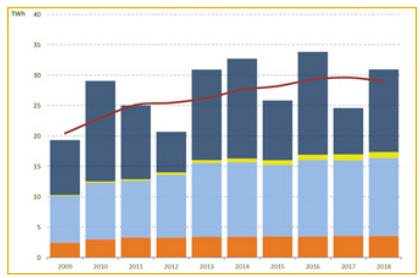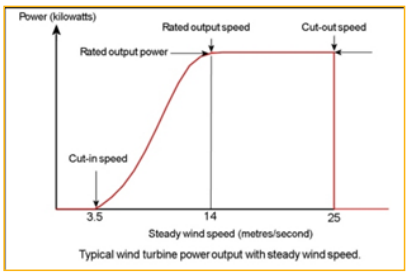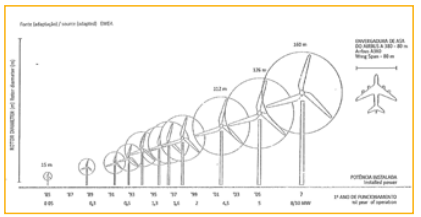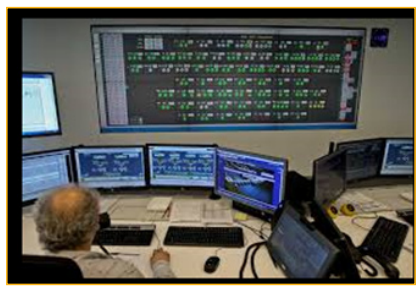Author(s): <p>António Brito* and Luís Neves</p>
Over-equipment in wind farms maintaining grid connection power is a new sustainable procedure that is allowing the increase of energy producing in wind farms.In Portugal, one of the fundamental lines for the structural modernization of the country is the pursuit of an energy strategy focused on increasing electricity production through renewable energy
The challenge of global warming and climate change is a remarkable opportunity for Portugal to invest in its endogenous resources, adopting measures whose objective is the autonomy and energy efficiency. A huge effort has been made in the last decade to increase the renewable energy mix in this country. The total renewable production, including large hydro, reached 30,7 GWh in 2018 [2]. Figure 1 shows the evolution of renewable energy in Portugal from 2009 to 2018 [2]. The rectangles at the bottom of the graph represent the combined use of biomass, municipal solid waste and biogas. The next rectangles represent the wind energy production. In 2018 this production reached 12,7 GWh. The following small rectangles represent the production of photovoltaic energy, which presently is having a huge increase in Portugal. This great interest is mainly due to the fact of technology been having great cost reductions, due to scale effects. Portugal is a very sunny country with 1 700 hours of sunshine per year. The last graph rectangles represent hydro origin energy, including large hydro with a power greater than 10 MW. The energy produced in this segment was 13,6 GWh [2].

Thus, it is evident the enormous importance that energy becoming from wind energy has been having in Portugal. The simplification of the procedure for the installation of over-equipment in wind power plants is one of the measures contributing to the increase of the production capacity of renewable energy, eliminating oil imports and reducing the use of the most polluting power plants. New concerns about environmental protection have made it necessary to focus more on environmental and energy policies to comply with international commitments, namely those relating to the limitation of greenhouse gas emissions. The promotion of renewable energies, mostly wind power, has special importance for the international and European Union context, reminding the objectives and targets Portugal is committed to, that is gradually reducing external energy dependence and reducing the carbon intensity of its economy. Through the limited installation of new wind turbines, called over- equipment, to increase installed power in wind farms, it is possible to increase their installed capacity. Thus, there will be lower impacts on the environment and the territory than the installation of new wind farms, while rationalizing the use of existing public utility electricity infrastructures, such as rural and mountainous roads, as well as electric infrastructures.
The models of energy purchase contracts were approved by the Portuguese Direction of Energy and Geology, which gives investors a guarantee in the relationship between the producers and the Last Resort Supplier. The security of the energy purchase is an essential factor in the evaluation of project financing. Some banks request loan assignments with scope of guarantee on the future remuneration of energy production. The guarantee of purchase of the production under special regime becomes an added value, which nullifies the investment risk. On the other hand, renewable energies have a special contribution to the security of energy supply of the country [3]. Special regime power production is always ensured by the network Operators, both transport and distribution, except in the cases where it is necessary to interrupt the energy supplies due to constraints in the network. But when these events occur interrupted producers are economically compensated by those who have not been interrupted [4]. Limiting global warming involves creating 120 to 160 thousand jobs in key sectors such as energy, transport, building, food and forestry, and investing in the energy transition sector. Withal it is necessary to control the most polluting sectors of the economy, dedicating one day a week to the professional training of workers in those sectors [5]. “Both Climate Change Adaptation and Disaster Risk Reduction aim to reduce the negative impacts of climate change and disasters on the natural environment, human society and economies by anticipating risks and uncertainties, and overcoming vulnerabilities.” [6]. Achieving the 2013 goals and targets of international agreements will only be possible through a collaborative effort from all sectors of society across all governance levels, both public and private [6]. “Both Climate Change Adaptation and Disaster Risk Reduction aim to reduce the negative impacts of climate change and disasters on the natural environment, human society and economies by anticipating risks and uncertainties, and overcoming vulnerabilities.” [6]. Achieving the 2013 goals and targets of international agreements will only be possible through a collaborative effort from all sectors of society across all governance levels, both public and private [6]. “As urban areas continue to grow their impact on the climate increases. Cities occupy only 2% of the world s landmass but they consume over 2/3 of the world s energy and are responsible for more than 70% of global CO2 emissions.” [9]. For the reasons explained above, the production of electricity through the using of a steady blowing wind has been of main importance in the production of renewable energy. Mainly from 2002, with the publication of Decree-Law n° 339-C/2001, of December 29th, there has been a widespread installation of wind farms in Portugal. The aerogenerators have been placed on the highest mountains, where there is more wind. The Portuguese annual power usage is about 2300 hours. The possibility of over-equipping wind farms, which is detailed in this article, is another possibility of producing more energy from renewable sources, using the existing infrastructures. In this way, the investment in the installation of new aerogenerators is reduced, thus allowing a reduction in the investment in new machines. This allows a reduction in the price of the energy produced, which means a global gain for the investors and the electricity customers. In 2013 new legislation was published (Decree-Law n° 35/2013, of February 28th). That legal framework allows the extension of the energy acquisition by the Last Resort Supplier by another period of 5 of 7 years after 2020. To get the benefit mentioned above the producers are paying a monthly compensation.

The accumulated experience and the new targets set for
the wind-powered electricity production have advised
over-capacity as an alternative form of investment,
increasing the installed capacity of wind farms.
This established the possibility of over-equipping up to
the limit of 20% of the power injection capacity in the
public utility grid, previously assigned by the General
Directorate of Energy and Geology.
previously assigned by the General Directorate of
Energy and Geology.
Therefore, over-equipment is not subject to
environmental impact assessment in the following
cases:
• When the over-equipment does not involve the
installation of 20 or more wind turbines and the distance
from another similar wind farm is not less than 2 km;
• When in over-sensitive areas over-equipment does
not involve the installation of 10 or more wind turbines
and the distances from another wind farm are not less
than 2 km.
It should be recalled that the injection power attributed
to the wind power plant remains unchanged despite
over-capacity.
Following the working group formed by the entities
APREN - Portuguese Association of Renewable Energy,
the Global Technical Manager of the National Electric
System, the Last Resort Supplier and the operators of
the Transport System Operator and the Distribution
System Operator, it was published the Decree-Law n°
94/2014, of June 24th, on the subject related to the over-
equipping of wind farms.
The technical conditions of stability and security of the
networks must be preserved.
However, it must be kept in mind that environmental
impacts on the territory resulting from the installation
of new wind turbines are reduced.


In O&M (Operation & Maintenance) office, it is ensured that the efficiency and operation of the wind turbines are the best possible, for example in carrying out preventive maintenance [14]. O&M control of the energy production (active and reactive) and the resolution of technical problems is carried out with the aid of the SCADA system installed in the control building of the wind farms, as exemplified in the figure below.

Regarding the energy measurement for billing purposes, it must be followed what is mentioned in the Guide for Measurement, Reading and Availability of Data, which was approved by the Portuguese Regulator.
In this way, the wind turbines that have been installed under the over-equipping regime must have their own telemetering equipment. For each integration period of 15 minutes, the telemetering of the main wind farm must be deduced from the telemetering concerning the over-equipment aerogenerators.
To simplify the operational process, an electronic self- billing process has been developed. Thus, every month the Distribution Network Operator provides the values of the energies affected to the over-equipment and to the main wind farm. Using these energies, the billing amounts allocated to the over-equipment and the main park are calculated. The simulations of the economic calculations made are then available on the internet site. Producers access this site and approve the simulations, or they can reject them if something is not right, which is very unusual.

The approval of the simulation will trigger the emission of the electronic self-billing. This automatic procedure is of most importance for the producers, because they have some difficulties in having all the data in the very beginning of each month. Small differences can be regulated using credit or debit electronic invoices as well. The producers are very pleased with electronic billing and they overpraise the digital platform developed.
